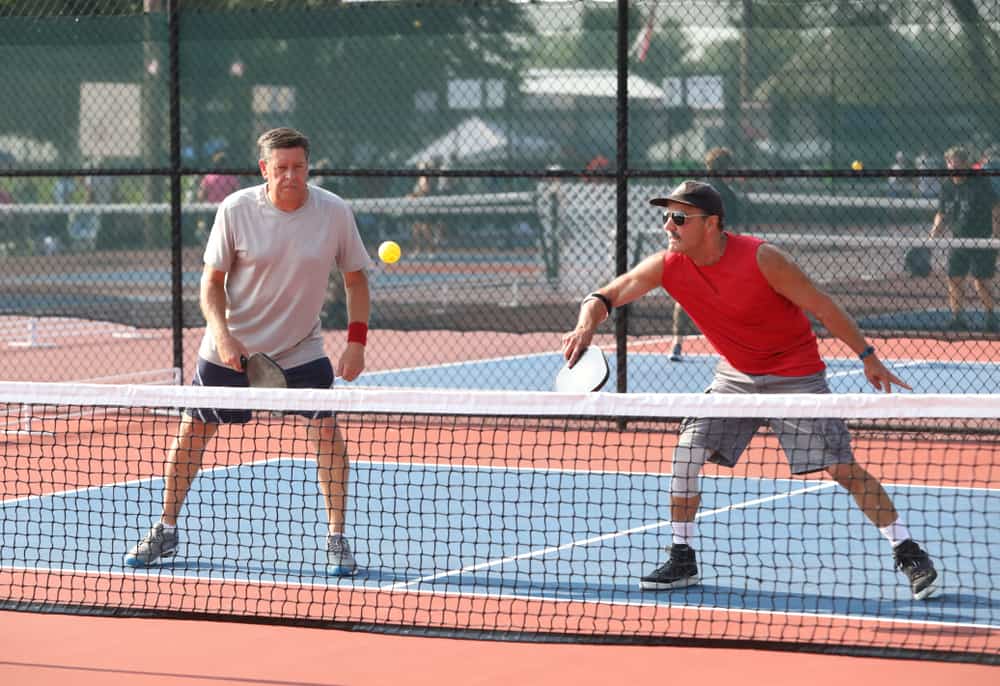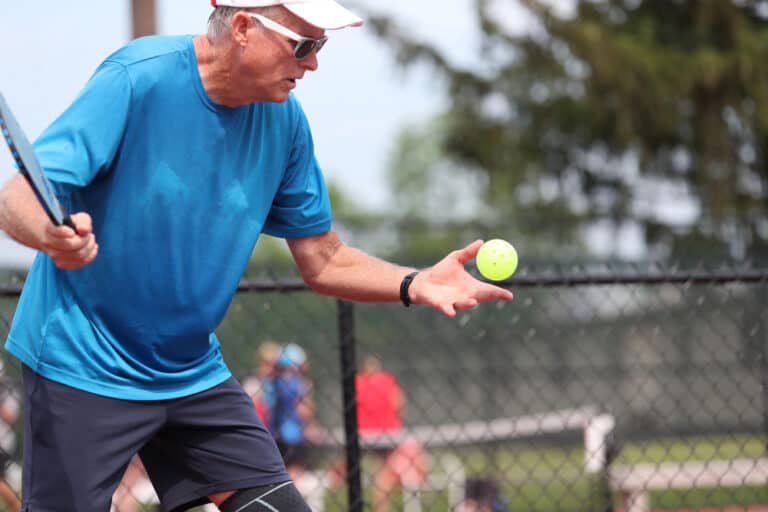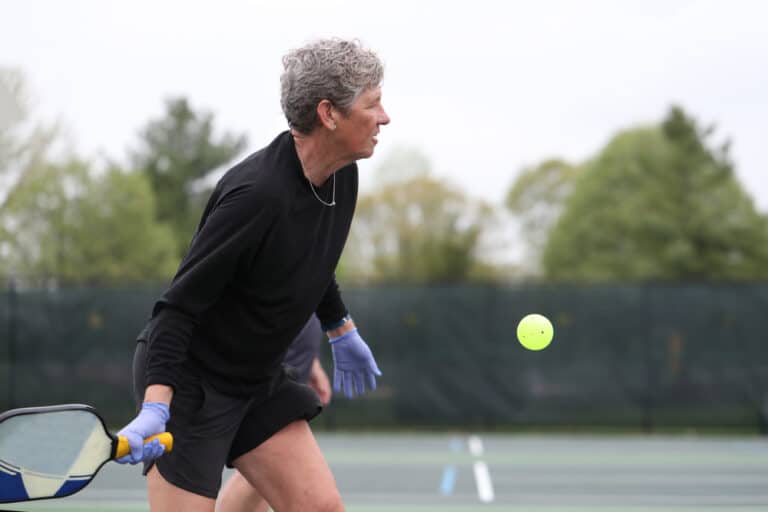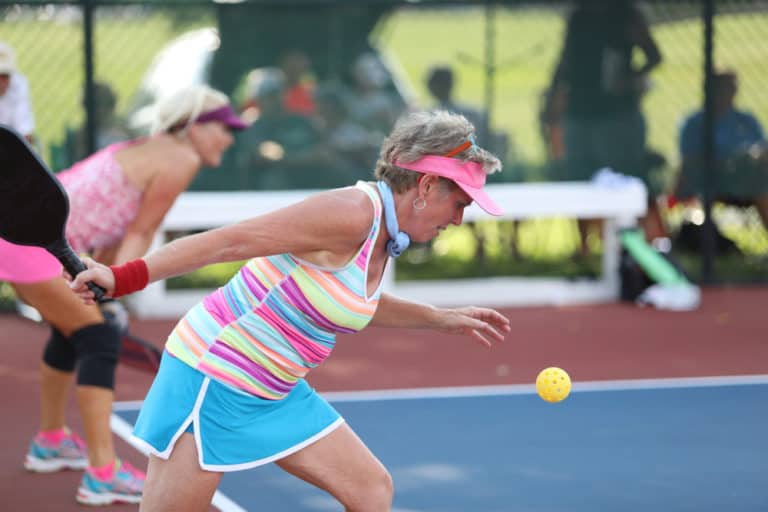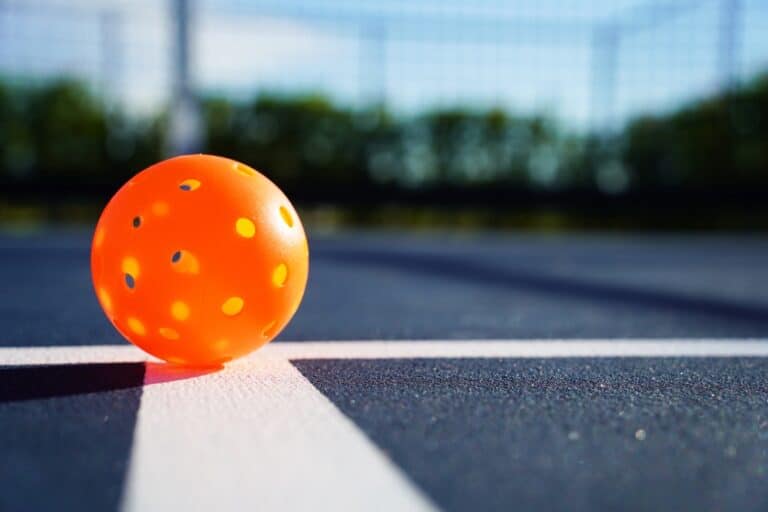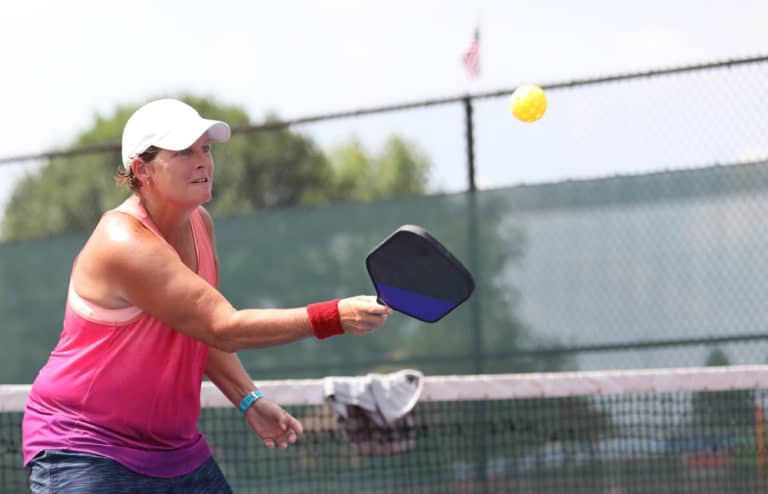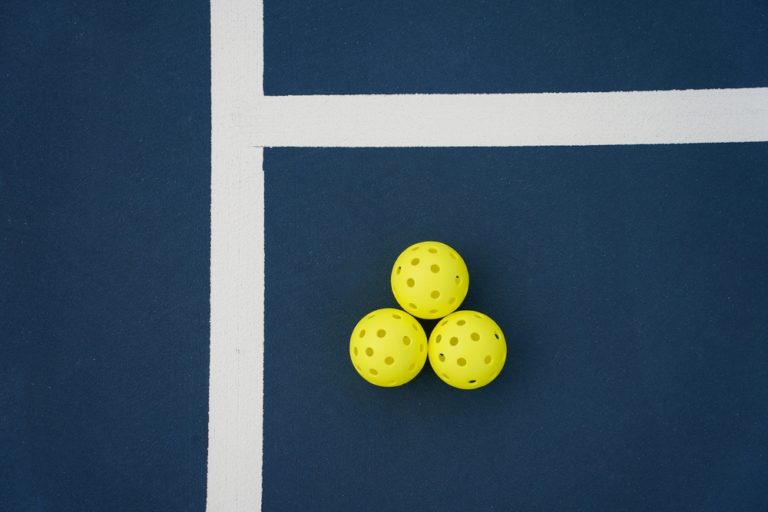How Many Points Is Pickleball Played To?
Pickleball as a sport has been growing steadily in popularity. It’s grown from a privately-played sport to competitive leagues and tournaments in well over 60 countries. And yet, many people are still uncertain about pickleball’s rules, and one of the questions that newcomers often ask is, how many points is pickleball played to? Is there even a fixed number, and how do I achieve that?
Pickleball is mainly played to eleven points, and the player(s) leading by at least two wins the game. This can go up to fifteen or twenty-one points in pickleball tournaments, but always leading by at least two points. Only the serving team can receive a point by winning a rally and vice versa.
Pickleball has become the fastest-growing sport in the US, and more than 4 million players are playing it recreationally. Pickleball is a cross between badminton, tennis, and table tennis, but the rules are generally less confusing than either of those four. Let’s see how to score more points in pickleball so that you can achieve the maximum points in the shortest time.
The Highest Point Count In Pickleball
Pickleball is played until one player or team has at least 11 points and leading by two. If the teams or players are tied 10-10, the match continues until one of the players or teams is leading by two points. This can cause the game to run well over the 11-point limit with no actual maximum number of points.
In some tournaments, games are adjusted to run for longer with a 15-point or 21-point minimum requirement, still with a two-point lead. In these cases, if the teams are tied at either 14-14 or 20-20, they continue playing until there is a two-point lead, regardless of how high the score may go in the process.
The maximum total points (11, 15, or 21) are determined based on the players’ skill level and ranking and the type of tournament that they are participating in. Non-tournament matches always go up to 11 points since that is the standard.
How Points Are Scored In Pickleball
It is commonly believed that the creators of pickleball found the scoring system used in tennis too confusing for beginners, so they simplified it considerably.
First of all, only the serving team will receive a point once a rally has been won. If a fault is being made and you are playing in doubles, your partner will now have a chance to serve. If another fault occurs, it is the opposite side’s turn to serve. If you are playing singles, it is easy; you and your opponent take turns serving.
The fact that pickleball is played on a points system of 11 or 15 points and wins by 2 makes it a quick-thinking, fast-paced, and highly competitive game. Let’s look more closely at the scoring system.
The Basic Scoring Rules Of Pickleball
Pickleball combines the gameplay and rules of tennis, badminton, and ping pong or table tennis. The sport can be played either outdoors or indoors, with different balls depending on the location. As long as you have a slightly modified tennis net and a court the size of a badminton court, you are set to play this exciting and energy-loaded new sport.
The paddles used to play pickleball are similar to those used in table tennis, and you also have a plastic ball that is simply named a pickleball. Pickleball can be played in doubles or singles matches, and the rules are adjusted according to that. The sport is straightforward enough for beginners to master, and players of all ages can enjoy it.
How To Score In Pickleball
As with tennis and other similar sports, you play the game and score points by hitting a ball back-and-forth across the court. Points are awarded one point at a time, and only if it’s the serving player or team scoring a point.
The Basic Pickleball Rules
- Start off with an underhand, cross-court serve.
- After it bounces on the court, the opposing team can return the ball by hitting it back to your side.
- The plastic ball is only allowed to bounce once per side; otherwise, it will count as a fault.
- Players must react quickly but never go into the area directly next to the net, also known as the kitchen, and the ball shouldn’t bounce in the kitchen either.
- Whether you’re playing singles or doubles, scoring works basically the same, except that only one person is serving on a side in singles, so there’s only one serving turn per side.
Understanding The Pickleball Court
- The right side of a pickleball court is called the even side, and the left side is the odd side.
- When the game starts, or after there is a “side out,” the serving player always serves from the court’s right side (also known as the even side).
- If it is a doubles game, both players on each team will have a turn to serve. This does not apply during the first sequence of the match.
- The score is indicated using three numbers, and the player who’s serving in the current rally is responsible for calling the score with all three numbers, in this specific order.
- The score of the serving player’s team comes first
- The score of the opposing team is called second
- The number of the player on the team that’s serving. For example, since the even side serves first, the player on the even side will be player one, whereas the player on the odd side would be player two. The numbers will obviously flip around when the other team is serving.
The player that’s about to serve calls out the score. For example, when you’re just starting, the score will be 0-0-1 since neither team or player will have scored a point yet, and the player on the even side is serving. When the player on the odd side serves next, they will call the score as 0-0-2. If you score a point during this rally, the score would then be 1-0-2.
When it’s the opposing side’s turn, the first player to serve will be on their team’s even side. This player will then call out the score as 0-1-1 since their score is now called first (which is 0), and then your score (1), and then another one indicating it’s the first player on their side that’s serving.
This score-calling pattern will continually change as points are scored and as the serving sides change.
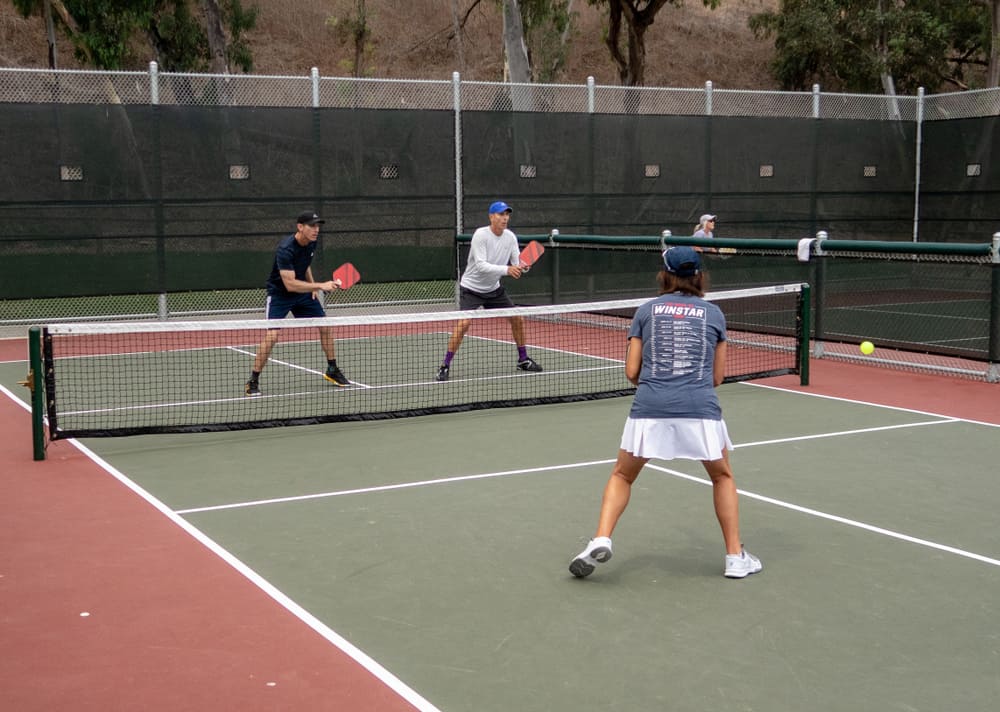
Other Rules For Scoring In Pickleball
- Whenever a team scores a point, the serving player moves to the odd side of the court and serves to the side that’s diagonally opposite from him. This process is repeated throughout the game as both sides score points.
- If neither side scores any points, both teams’ players stay in their current positions.
- The first player will continue serving until a fault is made and the rally is lost. Now it’s the second player’s turn to serve for their team.
- Once both players on a team have lost a serve, it is then time for the player on the even side of the second team to serve. This continues until one team achieves the required minimum winning score of 11, 15, or 21 points with a two-point lead.
Tips For Scoring More Points In Pickleball
It is a known fact that most points are won at the kitchen line, and this is achieved by neutralizing your opponents and helping you and your partner to progress from the baseline up to the kitchen line. Each pickleball point follows a specific sequence: a serve, the opponent’s serve, and a third shot or drive.
We already discussed the serve, so let’s look at the third shot and the drive.
What Is A Third Shot?
The third shot, also known as the drop shot, is one of the most important shots to add to your pickleball arsenal. One of the best ways to advance in pickleball is playing soft and then hitting drop shots. This is a very strategic shot and definitely one to practice and keep in your repertoire. However, this being said, the third shot is probably one of the most challenging shots to master.
A third shot or drop shot in pickleball is achieved by playing an unexpected soft shot. These delicate shots can be played from anywhere on the court, but they are most frequently played from the baseline. A third shot that is correctly executed will essentially go over the net and land in your opponent’s non-volley zone. It can not be returned, ultimately scoring a point for you or your team.
You want to achieve two objectives; the first is a successful third shot and the second objective is to give you and your partner time to advance to the non-volley line, as this is the zone where most rallies are ultimately won.
Once you have successfully managed to advance to the non-volley line and the third shot is returned by your opponent, you will have an opportunity to attack the ball and ultimately get it so that they cannot return the shot anymore.
What Is A Drive Shot?
When the situation calls for a hard shot, then it is time to bring out the drive shot. Drive shots are sudden hard shots that catch your opponent off-guard by sending the ball further away from where your opponent can easily reach.
When Is It Time To Play A Drive Shot?
It is time to bring out the drive shots when you notice the following situations:
- You notice that your opponent is struggling to defend against balls that are played hard. This is ultimately when your opponent keeps on returning the ball by consistently popping the ball up or when your opponent is intimidated by the pace of your drive shots.
- When your opponent is consistently returning to the transition area, showing that a hard drive is more effective than a soft third shot. This will return your opponent to the non-volley line, where most points are won.
- A hard forehand drive is called for when you notice that it is easy to throw your opponent off when they have a hard time reacting quickly to balls either on their left or right side.
- When the return serve is hit short, you will have an opportunity to drive a hard forehand because your opponent will most likely will not have a chance to return the shot.
- Confuse your opponent by being unpredictable. This is achieved by playing between third shot and forehand drives, so your opponent will never know what is coming next. Also, it is a good idea to go from one shot, for instance, soft, knowing that you are good at playing third shots and mixing it up with forehand drive, giving you a much-needed competitive edge.
Other Shots To Master
We have now established that the third shot and the forehand drive are probably two of the best pickleball shots to have in your arsenal. However, there are three more shots that we can look at that are also crucial to know to get you to the 11, 15, or 21 points faster or to break a 10-10 tie.
Dink
The dink is probably one of the first shots that you will be able to master. It is a soft shot hit on a bounce from the non-volley zone (the kitchen) that should arc over the net and land within your opponent’s non-volley area. Whether it is straight across or diagonally cross-court doesn’t matter.
An effective dink will arc downward as it crosses the net. This will have the desired effect of your opponent struggling to make the shot to return, and your opponent will probably play an overshot and lose the rally.
Overhead Smash
The overhead smash is a hard overhand shot that is directed downwards into your opponent’s court. This is usually played as a return from a lob, a high return, or a high bounce.
It is aimed at an open spot on your opponent’s court, with your paddle extended over the head at maximum height and with your elbow straight.
Lob Shot
The lob shot can either be played to reset the game to a slower pace, or it is often played to catch your opponent off-guard. A successful lob shot is when you shoot the ball over your opponent’s head, and they, in turn, retreat to get to the ball. However, it can just as easily backfire on you if your opponent returns it with an overhead smash.
Casual Pickleball Scoring
It is important to remember that, like most sports and games, pickleball is usually picked up by people who don’t care about playing professionally and simply want to have fun. They play casually and adapt the rules (including scoring) to suit them while they’re just relaxing with their friends and family.
Such matches may follow a simple “one point per serve, play until we’re tired” scoring system or a more complex “best out of three” or “best out of five” style. These rules are not an official part of the Professional Pickleball Association and may not be used in tournaments or formal competitions. After all, when you’re just playing for fun, the rules are really just suggestions.
Conclusion
When you play pickleball, you will want to reach the goal of 11, 15, or 21 points as quickly as possible while ensuring that you get the greatest possible lead in the process. One of the best tips is to be patient and wait for the opportunity to arise to play the right shot. Don’t try to force it; you will only lose points that way. Play for fun, strategize and keep your eyes open.
References
- https://usapickleball.org/what-is-pickleball/master-the-basics/
- https://www.quora.com/search?q=pickleball%20shots
- https://www.quora.com/What-tips-can-you-give-me-to-get-better-at-pickleball
- https://www.reddit.com/r/Pickleball/comments/mug9zc/does_anyone_have_any_tips_or_advice_on_how_not_to/
- https://www.reddit.com/r/Pickleball/comments/s68ndg/most_underrated_pickleball_tip/
- https://www.youtube.com/watch?v=RoheCHp6IDw
- https://www.youtube.com/watch?v=yB5w_cpFHbk
- https://www.youtube.com/watch?v=GAJLJTWZidg
- https://www.youtube.com/watch?v=JN71E6RjORc

